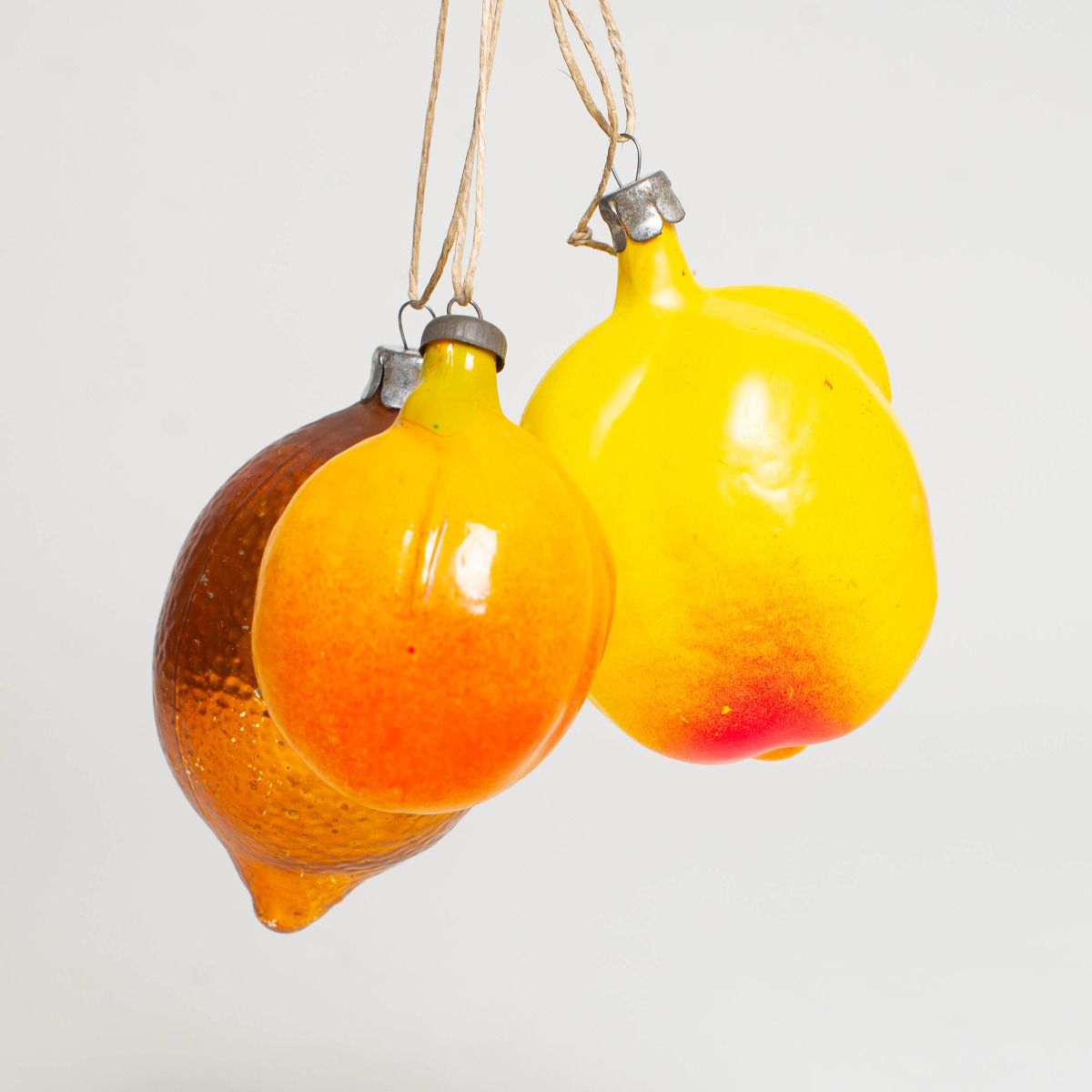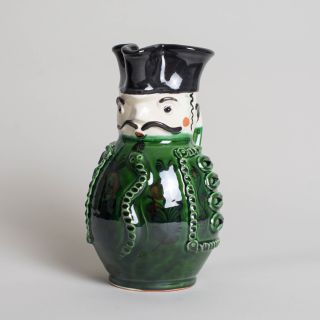International Wardrobe - Soviet New Years Citrus Ornaments
Once you order, simply send us a message, letting us know which fruit you would like!
the ornaments are sold individually
-Wenn Sie bestellen, schicken Sie uns einfach eine Nachricht, in der Sie uns mitteilen, welche Früchte Sie haben möchten
-die kugeln werden einzeln verkauft
Since 1937, the Jolka Festival
has been celebrated in Russia on New Year’s Day.
Jolka stands in Russian for „fir tree”,
which is splendidly decorated as a symbol of winter.
Originally, the festival was intended as a substitute
for the Christian Christmas, which the Soviets had banned
in the October Revolution of 1917.
Christmas with all its gifts
was considered a capitalist feast for the wealthy bourgeoisie.
The prohibition lasting until about 1935 when the New Year’s tree was revived
for the children, and celebrated with Soviet ornaments and decorations.
Ornaments of a religious nature were not allowed.
The themes of the small glass objects were as secular as the occasion of the festival.
There were no angels or Christ children, but things that surrounded people,
from traffic lights and cars to flower vases, soccer balls and teapots.
In addition, children and grandmothers, fairy-tale characters and again and again
Ded Moroz, the Russian Santa Claus, and his granddaughter Snegurochka.
And what could not be missing from any New Year tree was a clock,
with the hands on just before twelve.
Very important was also the department of fruits and vegetables, with garlic, pea pods and eggplant.
Another theme complex dealt with the propaganda with hammer & sickle ornaments, soldiers and submarines.
And with the world’s first space flight of the Soviets,
cosmonauts and rockets became en vogue.
Glass Ornaments from the East
***
Seit 1937 wird das Jolka-Fest
wird in Russland am Neujahrstag gefeiert.
Jolka steht im Russischen für "Tannenbaum",
der als Symbol des Winters prächtig geschmückt wird.
Ursprünglich war das Fest als Ersatz für das christliche Weihnachten gedacht
Ersatz für das christliche Weihnachtsfest, das die Sowjets in der
in der Oktoberrevolution 1917 verboten hatten.
Weihnachten mit all seinen Geschenken
galt als kapitalistisches Fest für die wohlhabende Bourgeoisie.
Das Verbot hielt bis etwa 1935 an, als der Neujahrsbaum für die Kinder wiederbelebt wurde
für die Kinder wiederbelebt und mit sowjetischen Ornamenten und Dekorationen gefeiert wurde.
Ornamente religiöser Art waren nicht erlaubt.
Die Themen der kleinen Glasobjekte waren so weltlich wie der Anlass des Festes.
Es gab keine Engel oder Christkinder, sondern Dinge, die den Menschen umgeben,
von Ampeln und Autos bis hin zu Blumenvasen, Fußbällen und Teekannen.
Dazu kamen Kinder und Großmütter, Märchenfiguren und immer wieder
Ded Moroz, der russische Weihnachtsmann, und seine Enkelin Snegurotschka.
Und was an keinem Neujahrsbaum fehlen durfte, war eine Uhr,
mit den Zeigern auf kurz vor zwölf.
Sehr wichtig war auch die Abteilung für Obst und Gemüse,
mit Knoblauch, Erbsenschoten und Auberginen.
Ein weiterer Themenkomplex befasste sich mit der Propaganda mit Hammer-
nd Sichelornamenten, Soldaten und U-Booten.
Und mit dem ersten Weltraumflug der Sowjets, wurden Kosmonauten und Raketen en vogue.
Glasornamente aus dem Osten
International Wardrobe
(EN) The aim of International Wardrobe is to give traditional and ethnic home textiles a prospering plattform. With the worldwide aquisition and sale of particularly beautiful, antique and vintage ethnic textiles, clothings telling more about the history and cultural background, International Wardrobe is to nourish a contemporary approach towards clothing for people as well as for furniture. Their principal interest, and the focus on research is in the field of folk costumes and other textiles, which traditionally tend to be hand-made. International Wardrobe work together with artisans in different countrys like Romania, India, Bangladesh and Laos..
International Wardrobe was founded 2009 by the art historian, ethnologist and stylist Katharina Koppenwallner.
(DE) Das Ziel von International Wardrobe ist es, traditionellen und ethnischen Heimtextilien eine prosperierende Plattform zu geben. Mit dem weltweiten Ankauf und Verkauf besonders schöner, antiker und alter ethnischer Textilien, also Kleidungsstücke, die mehr über die Geschichte und den kulturellen Hintergrund erzählen, will International Wardrobe einen zeitgemäßen Umgang mit Kleidung für Menschen sowie für Möbel pflegen. Ihr Hauptinteresse und ihr Forschungsschwerpunkt liegt im Bereich der Volkstrachten und anderer Textilien, die traditionell eher handgefertigt sind. International Wardrobe arbeitet mit Kunsthandwerker:innen in verschiedenen Ländern wie Rumänien, Indien, Bangladesch und Laos zusammen.
International Wardrobe wurde 2009 von der Kunsthistorikerin, Ethnologin und Stylistin Katharina Koppenwallner gegründet.


